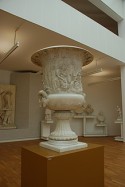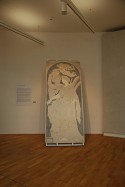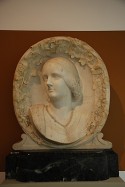The browser will either open the file, download it, or display a dialog.
|
Henry de Triqueti (1803-1874), scultore dei Principi Henry de Triqueti (1803-1874), scultore dei Principi |
|||||||||||||||||||||||||||||||||||||||||||||||||||||||||||||||||||||||||||||||||||||
|
|
Surrounded by picturesque mountains in Ligornetto, Switzerland, the majestic Museo Vincenzo Vela showcased the sculpture of the French Romantic sculptor Baron Henry de Triqueti this past spring and summer. Consisting of fourteen galleries of sculpture and related works on paper, Henry de Triqueti (1803-1874), scultore dei Principi was organized by the Musée des Beaux-Arts in Orléans, the Musée Girodet in Montargis (which owns a large collection of the works and models that were contained in the artist’s studio since his death) and the Museo Vela in Ligornetto. |
|||||||||||||||||||||||||||||||||||||||||||||||||||||||||||||||||||||||||||||||||||||
|
Triqueti, who was born into privilege and signed his first name “Henry” after 1850, did not really need to earn money from his artistic production. The lack of casts and reproductions of his works has probably contributed to his being a lesser-known sculptor of the nineteenth century, even though he completed some very important projects in France and England. He exhibited at the Paris Salon exhibitions somewhat regularly starting in 1831, but more importantly, he gained the favor of King Louis-Philippe of France, whose commissions for the Chamber of Deputies and for the Church of the Madeleine, both in Paris, kept Triqueti comfortably busy throughout the 1830s and 1840s. His major works of the 1860s were completed in England, including his Memorial Chapel to Prince Albert and his Shakespearean scenes for University College in London.1 |
||||||||||||||||||||||||||||||||||||||||||||||||||||||||||||||||||||||||||||||||||||||
|
The exhibition at the Museo Vela opened with two large and quite different sculptures on the ground floor of the museum, surrounded by the works of Vincenzo Vela from the permanent collection (fig. 1). In the center of the main gallery one learns of Triqueti’s work in decorative arts through his Vaso degli Israeliti in cattività a Babilonia (Vase of the Israelites in Captivity in Babylonia, 1854-57) a heavy and large marble vase exhibited at the Exposition Universelle of 1855 (fig. 2). More impressive, however, is the second introductory work, La Prosperità pubblica e la Pace (Public Prosperity and Peace, 1845), a large marble and blue-gray-colored cement relief made using the tarsia process, a method of inlaying marble onto a cement background (fig. 3). In this piece Triqueti created a bas-relief allegory which had its origins in the pietre dure manner. This sculpturemarked the beginning of the sculptor’s involvement with the tarsia process, which he revived, as well as his participation in producing art for tombs and memorials to heroes. Originally, this unfinished tarsia was begun as part of a project to decorate the walls of the tomb of Napoleon I in the crypt of Les Invalides, where Napoleon’s remains had been recently returned to Paris from St. Helena. Triqueti had studied the tarsia process during his travels to Siena and Venice, where it had been produced since the fourteenth century with materials such as wood and ivory. It was a method that he would return to on an even larger scale in his memorial to Price Albert in Wolsey Chapel (now Prince Albert Chapel) at Windsor Castle (1864). |
||||||||||||||||||||||||||||||||||||||||||||||||||||||||||||||||||||||||||||||||||||||
|
Although one quickly learns that La Prosperità pubblica e la Pace was never placed in Les Invalides, the work immediately introduced Triqueti as an innovative sculptor for whom light touches of color would become a hallmark. This was appropriate and timely; color in sculpture would return as a theme in some of the year’s major sculpture exhibitions, particularly in the United States. New Yorkers received their introduction to pietre dure in the Metropolitan Museum of Art’s sumptuous summer exhibition Art of the Royal Court: Treasures in Pietre Dure from the Palaces of Europe, and Californians were reminded of the subject in the Getty’s The Color of Life, Polychromy in Sculpture from Antiquity to the Present. One notices Triqueti’s restrained but evident use of color, gilding and mixed media throughout the exhibition, in such works as Dafni e Cloe (1849), his small terracotta musical angels and angles with incense burners, and his magnum opus at Windsor Castle (fig. 4). |
||||||||||||||||||||||||||||||||||||||||||||||||||||||||||||||||||||||||||||||||||||||
|
At the Museo Vela, the special exhibitions resume on the second floor. After an additional introductory space containing Triqueti’s chronology and a marble bust of the artist by his student and assistant, Susan D. Durant (1827-1873), the exhibition formally began (fig. 5). Students of H.W. Janson’s text 19th-Century Sculpture (1986, sadly out of print) might remember Henry de Triqueti for his bronze doors for the Church of the Madeleine in Paris, or for his cenotaph dedicated to Ferdinand Philippe, Duc d’Orléans (1810-1842), now installed at the Church of Notre-Dame-de-la-Compassion, Chapelle St.-Ferdinand in Neuilly-sur-Seine. Although the cenotaph was reproduced in Janson’s book, it was not discussed in depth; in the exhibition at the Museo Vela, however, a large-scale plaster maquette (1842) for the work takes center stage (fig. 6). Triqueti’s funerary bust of the Duke (1844) in life-sized marble, has none of the tight lifelessness of a death mask, but instead shows the Duke as if asleep, the youth of his thirty-two years never fading, the evidence of his accidental death in a carriage accident nowhere apparent (fig. 7). |
||||||||||||||||||||||||||||||||||||||||||||||||||||||||||||||||||||||||||||||||||||||
|
The gisant-style cenotaph was originally designed by Ary Scheffer; an angel in a kneeling pose, designed and carved by the Duke’s sister, Princess Marie d’Orléans, some years before her own death, was included with the original cenotaph at the request of Ferdinand-Philippe and Marie’s mother. (Incidentally, Marie d’Orléans’ work was featured in an exhibition at the Louvre this past summer.) The idea of the bas-relief of the weeping angel was Triqueti’s own. Triqueti, as King Louis-Philippe’s official sculptor, sculpted the work based on Scheffer’s drawings and designs. The plaster in the exhibition was grand in size and grander in execution; the Duke, still in his uniform and with his shirt unbuttoned so as to aid his last breath, dies before us. No sculptor would capture the moment of death more realistically and gracefully in a gisant until Jules Dalou captured the same moment in his Tomb of Victor Noir some forty-eight years later (1890, Père Lachaise Cemetery, Paris). |
||||||||||||||||||||||||||||||||||||||||||||||||||||||||||||||||||||||||||||||||||||||
|
The bronze doors for the Church of the Madeleine were discussed in the exhibition through the presentation of some of the small maquettes related to the project. A large photograph of the doors, alongside an equally large photograph of Lorenzo Ghiberti’s east doors of the Florence Baptistry (known as the Gates of Paradise, 1424-1452) also accompanied these objects (fig. 8). Although it was of course not possible to bring the doors to Ligornetto, and clearly the best way to experience this work is to visit the doors in person, the museum did its best to present Triqueti’s most important early sculptural project without having the doors themselves to exhibit. Very charming additions to this room were the small bas-reliefs made of clay by young visitors to the exhibition, which were placed around the door frame of the room (if you look closely at figure 8 you can see some of these on the far right of my photograph). This added a special touch, a nod to Triqueti’s continued effect on today’s young museum visitors, to an otherwise subdued gallery. |
||||||||||||||||||||||||||||||||||||||||||||||||||||||||||||||||||||||||||||||||||||||
|
The subject of sculpted door projects is one of great interest within the history of sculpture. The tradition of sculpted bronze doors was an Italian one and Triqueti was certainly inspired by Ghiberti’s East Doors of the Florence Baptistery. Earlier bronze door projects, made outside of Italy, but nonetheless important, include those at Hildesheim in Germany and at Hagia Sophia in what is now Istanbul. Triqueti’s own doors certainly inspired Auguste Rodin’s unrealized door project for the unrealized Museum of Decorative Arts in Paris, known as the Gates of Hell (1880-1917). Triqueti’s doors are just one example of the weighty Christian influence strongly present in his works, discussed eloquently in both the Italian and French catalogues for this exhibition by Isabelle Saint-Martin. In Florence and Hildesheim, the bronze door projects deal in part with the Fifth Commandment, “thou shall not kill,” and used scenes from the first murder – Cain’s killing of his brother, Abel – to depict it. Triqueti also explored Cain’s sin in his doors; in the exhibition some very charming painted plaster studies of the heads of Cain, his wife and his child were presented, lent by the Musée Girodet in Montargis. |
||||||||||||||||||||||||||||||||||||||||||||||||||||||||||||||||||||||||||||||||||||||
|
Triqueti’s medallion-format sculptures were among the highlights of the exhibition. His Busto-medaglione di Blanche de Triqueti (1852), a marble relief of his daughter, is luxurious in its carving and harks back to Renaissance-era models (fig. 9). Blanche modeled for her father and inspired many of his works. The bold carving of the ivy that frames her bust is juxtaposed with the fine circular carving that makes up the floral detailing of the neckline. She seems to be about to break into a smile, but her eyes have the blank eyeballs usually reserved in sculpture for spiritual or otherworldly figures. Later in the exhibition, Triqueti’s high-relief medallion Mosè affidato da sua madre alle acque de Nilo (Moses Set Out into the Nile by His Mother, 1857) is a tour-de-force of detailed carving, elegant modeling of the figures, and strong emotive power (fig. 10). Moses being exposed in a basket and set into the river Nile by his mother, Jochebed, was a subject of great interest to Triqueti, one which he returned to in many of his drawings and sculptures.2 We are presented with the most heartrending moment, from the book of Exodus (2: 1-4) when “the goodly child” will be given up by his mother forever. Jochebed’s head is lowered and her eyes closed, filled with the sadness of her deed, but also with the resigned hope that she will be able to save the child by her actions. Triqueti’s eye for details is stunning, and small details such as the grasshopper intertwined with the reeds (fig. 11) and the Michelangelesque touch of a signature across the breast of Jochebed (fig. 12) made this work one of the great jewels of the exhibition. |
||||||||||||||||||||||||||||||||||||||||||||||||||||||||||||||||||||||||||||||||||||||
|
The most significant gallery in the exhibition contains maquettes and a reconstruction in “miniature” (actually a 1/5 scale reduction) of Wolsey Chapel (now called Albert Memorial Chapel) at Windsor Castle, containing the monument to the late husband of Queen Victoria, Prince Albert (figs. 13, 14). Triqueti received this Chapel commission directly from the Queen in 1864, his largest and most important project since his work on the Madeleine; the Albert Memorial took ten years to complete. The room also included a number of plaster maquettes (with pencil marks for eventual “pointing up” or enlarging the works) in quatrefoil and square-shaped designs for the chapel, including Lo Scultore di scudi (The Sculptor of Shields, 1867, fig. 15). The 1/5 scale reduction in Salle XVI at the Museo Vela was originally created for the exhibition in Montargis and was a real treat to explore in Ligornetto. The visitor got a strong sense of the plan for the chapel, Triqueti’s cenotaph, and the abundant use of the colorful tarsia process within the chapel. Of course the reduction does not substitute for the experience of actually visiting Windsor Castle, but it was a very innovative stand-in until one can plan a trip to Windsor. If one can imagine the immensity of Triqueti’s project, one can also imagine the immensity of Queen Victoria’s grief, she who became the “widow of Windsor,” after Albert’s death. |
||||||||||||||||||||||||||||||||||||||||||||||||||||||||||||||||||||||||||||||||||||||
|
The exhibition in Ligornetto ended with some drawings based on Triqueti’s travels and his works based on mythological figures. The drawings from his travels included early travels to Switzerland and Italy in the 1830s and again in the early 1860s, making his exhibition in Ligornetto (which is in the canton of Ticino in Switzerland and borders Italy) even more relevant (fig. 16). The final gallery included some very small but elegantly modeled terra cotta and plaster works based on mythological figures such as Clizia morente al declinare del sole (Clytie Dying to the Setting Sun, 1851); Penelope (1863) and Genoveffa di Brabante (1855). |
||||||||||||||||||||||||||||||||||||||||||||||||||||||||||||||||||||||||||||||||||||||
|
The exhibition was accompanied by a catalogue Henry de Triqueti (1803-1874), scultore dei Principi with contributions from Isabelle Leroy-Jay Lemaistre, Philip Ward-Jackson, Nicole Garnier-Pelle, Anne Dion-Tenenbaum, Emmanuelle Brugerolles, Isabelle Saint-Martin, Véronique Galliot-Rateau, Sylvia Allen, Richard Dagorne and Marie Clarac. Basically the catalogue contains Italian translations of the essays from the French catalogue, which accompanied the French venues. Gianna A. Mina’s presentation of the exhibition and Philip Ward-Jackson’s essay on Triqueti’s voyages in Italy and Switzerland are, however, unique to this catalogue. Both texts contain an up-to-date bibliography, including a bibliography of Triqueti’s own writings, which covered subjects as wide-ranging as art, charity and religion. |
||||||||||||||||||||||||||||||||||||||||||||||||||||||||||||||||||||||||||||||||||||||
|
Isabelle Leroy-Jay Lemaistre’s contribution to the catalogue was not small: she provided the overview of Triqueti’s career in both the French and Italian editions. I remember having lunch in Paris with her many years ago when she had mentioned her own work on Triqueti. It was the first time I remember hearing about the artist, and I was intrigued by his memorial projects as well as Madame la Conservatrice’s enthusiasm about a future exhibition centered on Triqueti’s work. At that time there was the possibility that such an exhibition might come to New York. Sadly, that leg of the exhibition could not be realized, but even if art lovers and students of sculpture missed the Triqueti venues in Ligornetto or in France, the publications that have been produced as a result of these exhibitions are richly illustrated and will greatly inform all interested students of sculpture about Triqueti’s contributions, a no-longer-forgotten master of the July Monarchy and Victorian England. Pilgrimages to the sites of Triqueti’s works are now required. |
||||||||||||||||||||||||||||||||||||||||||||||||||||||||||||||||||||||||||||||||||||||
|
Caterina Y. Pierre, Ph.D. Related Links: Official Site for the Museo Vela: |
||||||||||||||||||||||||||||||||||||||||||||||||||||||||||||||||||||||||||||||||||||||
|
I wish to express my thanks to Dr. Gianna A. Mina, Director of the Museo Vela and curator of the Henry de Triqueti exhibition, for her helpful assistance in Ligornetto and for permitting me to photograph the exhibition for this review. My study trip to Europe in 2008 was made possible through a PSC-CUNY Travel Grant. 1. Peter Fusco and H. W. Janson, The Romantics to Rodin, French Nineteenth-Century Sculpture from North American Collections (New York and Los Angeles: George Braziller and Los Angeles County Museum of Art, 1980), 359. 2. Véronique Galliot-Rateau, “Figure femminili,” in Henry de Triqueti (1803-1874), scultore dei Principi (Bern : Ufficio federale della cultura e autori, 2008), 144. |


















